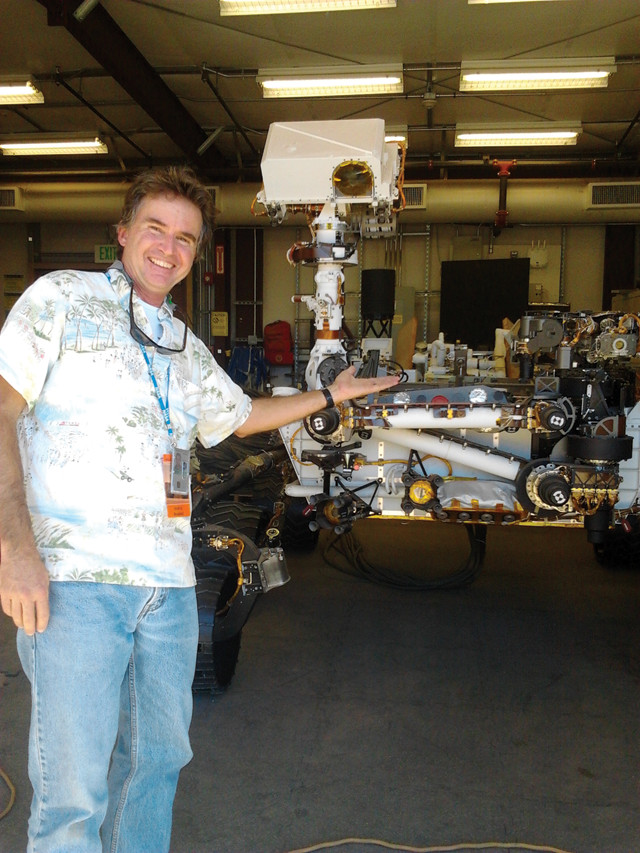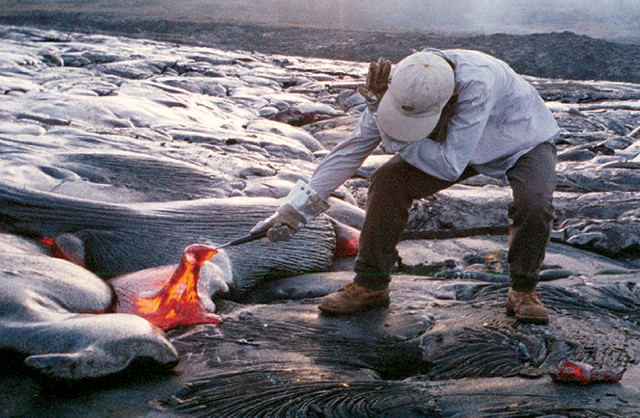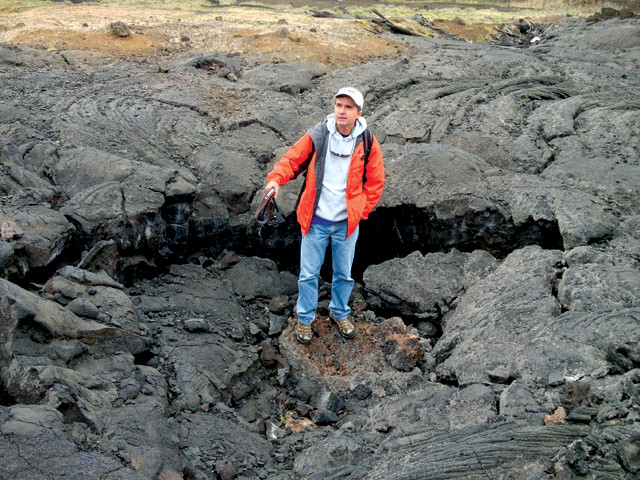
by Catherine Hudson Friday, August 3, 2018

Volcanologist Scott Rowland, who studies Hawaiian lava flows and also works as a volcanologist on the Mars Curiosity Rover team, with the testbed rover at the Jet Propulsion Laboratory in Pasadena, Calif. Credit: Megan Kennedy-Wu.
Hawaii seems like an ideal place to nurture a budding volcanologist. Kilauea, on the Big Island, is one of the world’s most active volcanoes. And the terms used to describe the main types of basaltic lava flows — aa and pahoehoe — are Hawaiian words.
Yet when Scott Rowland returned to his home on Oahu after earning a bachelor’s degree in geology at Oregon State University, intent on heading to graduate school, he was torn between studying volcanoes or groundwater. Ultimately, he chose to study Hawaii’s basalt lavas as a graduate student at the University of Hawaii at Manoa.
Rowland is now a faculty member in the same department in which he earned his doctorate. He spends most of his time teaching and pursuing three main research projects: modeling how channelized lava flows advance, mapping thick lava flows on the island of Molokai, and, slightly farther afield, assigning operational directions to the Mars Curiosity rover a few times a month.
But since Kilauea’s long-running eruption changed its character right at the end of April, his daily activities have become livelier and more varied. Active Hawaiian volcanoes are officially monitored by the U.S. Geological Survey (USGS) and faculty at the University of Hawaii’s Hilo campus, but Rowland has taken an active role in communicating the latest events, speaking with news media and research colleagues.
Rowland talked with EARTH about the recent volcanic activity on the Big Island, the evolution of the eruption, and the challenges involved in communicating to the public during an ongoing natural hazard event.
*Editor’s Note: This interview took place June 19, after which additional eruptive events occurred. On Aug. 2, however, both the eruptive activity in Leilani Estates and the collapse activity at Kilauea’s summit stopped. At the time of this posting on Aug. 14, neither has resumed.
CH: What is your role related to the recent volcanic activity on the Big Island?
SR: All the activity is officially monitored by USGS and University of Hawaii at Hilo faculty. I’ve only been on site briefly. But I have done a lot of interviews for news media and I try to keep my colleagues up to date with what’s happening.
CH: Can you describe the evolution of the recent eruptions of Kilauea?
SR: Pu̒u O̒o is a scoria and spatter cone located on the East Rift Zone of Kilauea volcano that has been erupting since 1983. Typically, the lava from Pu̒u O̒o vent has spilled over the top of the cone or entered lava tubes leading downslope, and the average effusion rate has been 3 to 5 cubic meters per second. This slow flow has been going for decades more or less continuously and usually empties into the ocean.
Beginning in late March, magma accumulated in the Pu̒u O̒o vent. The lava lakes at Pu̒u O̒o and up at Halemaumau Crater at the summit of Kilauea were both rising (we know there is a connection between them). It seems there was some type of blockage at the outlet of Pu̒u O̒o causing magma to back up to the summit. Rather than flowing out the flank of Pu̒u O̒o cone as it has in the past, the magma flowed out the bottom of the cone into the East Rift Zone and traveled underground. It drained very rapidly from Pu̒u O̒o and migrated down the rift zone. This was tracked by localized earthquakes, which eventually centered around Leilani Estates (a residential subdivision). The earthquakes were so shallow that residents could hear them as well as feel them. Cracks began to form in the area, indicating that magma was working its way toward the surface.
May 3 was when the first small eruption took place in Leilani Estates, and the cracks and vents spread both downslope and upslope along the rift from that eruption. For the first week or so, a little lava would come out of a vent and then stop. The chemistry of that lava indicated that it was not magma that had drained from Pu̒u O̒o, but rather magma that had been sitting in the rift zone for some time and was now being pushed out by the Pu̒u O̒o magma.
By May 18 and 19, the vents had propagated outside of Leilani Estates and the composition was more similar to that of Pu̒u O̒o magma. The lava advanced rapidly to the south and entered the ocean for about a week. Then that activity wound down, but one vent (Vent 8) back in Leilani Estates reactivated around May 25 or 26. The lava fountain [at Vent 8] reached 60 meters high and fed a channelized lava flow that reached and flowed right through the community of Kapoho, destroying about 500 homes, which was devastating.

The constant volcanic activity on Kilauea allows volcanologists to easily collect fresh lava samples and study their composition, gas content and viscosity. Credit: Ruth Weatherwax.
CH: While eruptions were taking place downslope along the East Rift Zone, what has been happening back up on the summit?
SR: The walls of the lava lake at Halemaumau became unsupported when the lava lake drained, which triggered collapse. The surrounding ground has started to subside due to the draining of both the lava lake and the larger underground magma chamber. The subsidence is concentrated at Halemaumau and decreases farther away, but it has caused cracks in the nearby highway and in the floor of the Hawaiian Volcano Observatory’s building [at the summit].
While the lava lake was still exposed, rubble from the crater walls dropped into it, causing explosions that released both gas and volcanic ash. There also may be some groundwater providing steam for the explosions, but it seems more likely that it is gas in the magma.
CH: How does this eruption compare to other eruptions in Hawaii?
SR: Compared to other Hawaiian eruptions, it’s been remarkable how persistent this relatively high effusion rate — 100 cubic meters per second is the estimate USGS has published — has lasted. Mauna Loa and Kilauea have both erupted at rates higher than that before, but never for this long, at least that we know of. This rate has persisted for a month now, and that is very puzzling. That’s the most amazing aspect, the duration at a high eruption rate.
CH: How might this eruption influence our views of past eruptions?
SR: [During an eruption] in 1924, the violent explosions were thought to be purely generated by the interaction of the groundwater with hot rock, with maybe a little magma involved. That doesn’t seem to be the case with the current eruption. USGS believes the explosions occurring now are at least partially driven by magmatic gases. This hypothesis is based on the chemistry of the gases being collected and on the morphology and type of particles coming out. Now, USGS is starting to question the interpretation of the 1924 eruption, trying to determine if it was perhaps more magma-driven than originally thought. After the current eruption has settled down, USGS may take another look at the 1924 eruption.

Rowland teaches at the University of Hawaii at Manoa, where volcano-focused field trips abound. On this field trip to Makaluapuna Point on West Maui, Rowland explains how lava flowed around a small outcrop of older lava, then inflated upward, leaving the old lava well below the level of the new lava. Credit: Andy Ryan.
CH: How has news about the eruption been communicated to the public?
SR: It’s mostly been via local TV news, print news and a lot of social media. There are a number of folks who live in the vicinity of the eruption who post videos and try to keep friends and neighbors updated. Of course, there’s a large amount of information USGS posts on websites, including maps, photographs, real-time seismic data, tilt data, webcams and even a live YouTube video of the caldera. USGS has been my main source of information. They established a Facebook page, which allows rapid interactions with the public. USGS has done a really good job of responding to people’s questions, and most of the time the questions the public asks show their natural wonder and curiosity for the topic.
The National Guard, County Civil Defense, USGS, and local police and fire departments have radios and helicopters, and the lines of communication appear very effective. There are community centers where people can gather for information and drop off donations — the community has pulled together very well.
CH: What questions about the eruption remain?
SR: The current ash eruptions and summit earthquakes are occurring in a relatively regular pattern. Pressure is not being released until a sufficient amount builds up and causes an explosion, but the exact cause of the eruptions remains unknown.
And why did the vents form within Leilani Estates as opposed to a different location along the rift? The reason the magma was pushed out and erupted at that specific location is unknown.
The other major questions are: What caused the magma to break out the bottom of Pu̒u O̒o? Pu̒u O̒o has erupted lava from its side before, but why did the lava lake suddenly drain and exit at the bottom of the cone into the rift zone? Was there a big pulse of magma that came into the volcano and set all of this in motion?
CH: What are your personal predictions for the future of this eruption?
SR: I made a bet with a colleague that it would end tomorrow (June 20), but I’m guessing I’ll lose that bet, so don’t listen to me! In all seriousness, we must consider previously erupted volumes and the volume of the magma chamber at Kilauea, which has not been emptied yet. So, it seems possible this eruption may last longer.
© 2008-2021. All rights reserved. Any copying, redistribution or retransmission of any of the contents of this service without the expressed written permission of the American Geosciences Institute is expressly prohibited. Click here for all copyright requests.